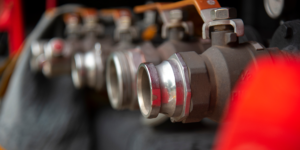A good fire sprinkler system is essential for safeguarding your home and family from fires. These systems swiftly extinguish flames, providing residents time to exit safely. Like any mechanical system, fire sprinklers need regular maintenance to work when you need them most.
The importance of fire sprinkler systems
Fire sprinkler systems save lives and property from fires. Early fire detection and control systems minimize damage, injury, or death.
Rapid fire response is a major benefit of fire sprinklers. Sprinklers operate when heat or smoke is detected, unlike hand extinguishers. This fast approach can save a tiny flame from escalating.
Even when the buildings are empty, fire sprinklers protect them 24/7. Your property is protected from fire risks day and night.
Understanding the components of a fire sprinkler system
Sprinkler systems are crucial to any building’s fire defense. Understanding fire sprinkler system components is essential for good operation and reliability.
Sprinkler heads are an essential part of fire sprinkler systems. High temperatures are detected by this little ceiling device’s heat-sensitive element. The sprinkler head automatically releases water when the temperature hits 135 degrees Fahrenheit.
Each sprinkler head has a network of pressurized water, air, or nitrogen gas lines. Sprinklers activate these pipes to spread water throughout the structure.
Fire sprinkler systems also have valves and control mechanisms to manage water flow and pressure. These mechanisms make sure emergency water flows just where needed.
Checking for damage or malfunctioning components in your fire sprinkler system is essential for effective maintenance. Check all visible pipes, valves, and heads for leaks or corrosion.
Testing your fire alarm panel regularly can reveal faults with alarm-sprinkler activation signal communication. Checking valve pressure gauges can also reveal water supply or distribution issues.
Documenting all fire sprinkler system maintenance helps maintain compliance with local requirements and gives vital information for future reference.
Understanding these components can help you understand how they protect lives and property from fires. By familiarizing yourself with these factors and doing regular preventative maintenance checks, you can improve fire protection reliability and give yourself and others peace of mind.

Types of preventative maintenance for fire sprinklers
Fire sprinkler systems need regular maintenance to work properly. These preventative maintenance steps are recommended:
- Visual Inspections: Check sprinkler heads, pipes, and fittings for damage or corrosion regularly. This can spot flaws before they become major.
- Testing Alarms: Fire sprinkler alarm systems should be tested regularly to ensure proper operation. Smoke detectors, heat sensors, and other alarms are checked.
- Flushing the System: Debris can build up in fire sprinkler pipes, reducing performance. Flushing the system removes buildup and optimizes water flow.
- Check Water Pressure: Fire suppression requires proper water pressure. To ensure system pressure, check it regularly.
Consider having a competent technician do routine maintenance on your fire sprinkler system at least once a year. They will perform more thorough inspections and tests to ensure code compliance.
You may improve the reliability of your fire sprinkler system by routinely performing preventative maintenance and employing professionals! Always remember that prevention is better than emergency failures!
Frequency and timing of maintenance checks
Fire sprinkler system reliability depends on maintenance frequency and timing. To detect system performance difficulties, regular inspections should be done.
Annual expert inspections are advised. More regular inspections may be needed based on system age, location, and local laws. Industrial facilities and buildings with sensitive equipment may need quarterly or monthly checks.
Inspections should test and evaluate all system components, not just visible ones. This includes evaluating pipes for corrosion or leaks, valves for functionality, water pressure, and sprinkler head flow tests.
Common issues with fire sprinklers and how to address them
Fire sprinkler troubles can result from age, environmental conditions, and faulty maintenance. Debris and corrosion often clog sprinkler heads. The water may not flow correctly during a fire. Sprinkler heads should be inspected and cleaned regularly to fix this.
Leaks in system pipes and fittings are prevalent. This wastes water and reduces firefighting efficacy. Leak detection and immediate repair should be part of regular inspections.
Mechanical failure or damage may prevent fire sprinklers from activating. Each sprinkler head should be tested routinely to guarantee proper operation.

Benefits of regular maintenance of fire sprinklers
Fire sprinklers must be maintained regularly to safeguard your property and loved ones from fires. Regular fire sprinkler system preventative maintenance has several benefits.
Maintenance detects issues before they become big concerns. Technicians can discover damaged parts, leaks, and clogs that could affect fire sprinkler operations by performing routine checks. Addressing these issues quickly prevents further damage and ensures your system works properly when needed.
Regular maintenance extends the fire sprinkler system. Like any mechanical equipment, appropriate maintenance can extend its lifespan. Valve and nozzle wear can be prevented by cleaning, lubricating, and inspecting.
Scheduled maintenance also meets local norms. To guarantee fire sprinkler system safety, fire codes frequently demand periodic testing and inspection. If issues arise, neglecting these duties may result in sanctions.
Conclusion
Protecting your property and loved ones from fires requires reliable and effective fire sprinkler systems. Regular preventative maintenance strategies can greatly reduce fire sprinkler failure.
Keep in mind that fire sprinkler systems are not automatic. They need care to be ready for emergencies. By understanding your system, doing regular maintenance checks, addressing common faults quickly, and following suggested servicing intervals, you can rest assured that your fire sprinklers will work when needed.
